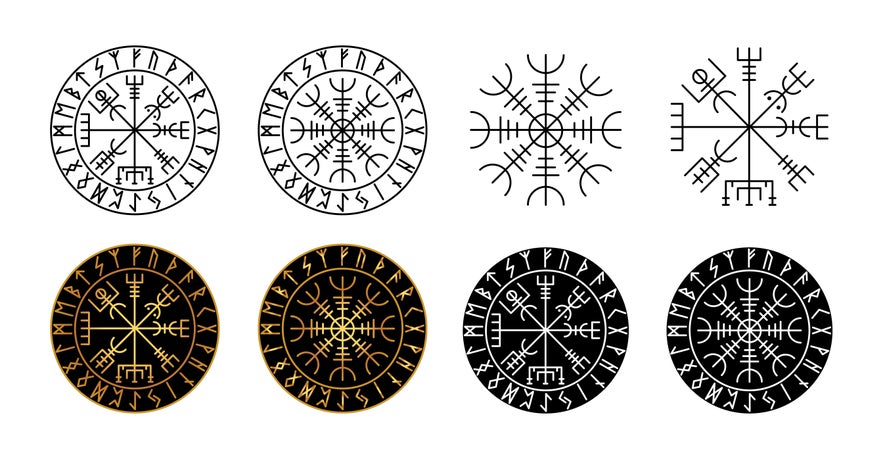Discover Vegvisir and Aegishjalmur, two powerful Icelandic staves used in folk magic for guidance and protection. Learn what sets them apart and why they continue to hold meaning today.
Vegvisir and Aegishjalmur are two of the most well-known Icelandic symbols today. You’ll see them in tattoos, jewelry, artwork, and even pop culture. In English, the Vegvisir is called the Viking compass. The Aegishjalmur is known as the Helm of Awe. Both symbols carry powerful meanings of protection, guidance, and strength.
Why You Can Trust Our Content
Guide to Iceland is the most trusted travel platform in Iceland, helping millions of visitors each year. All our content is written and reviewed by local experts who are deeply familiar with Iceland. You can count on us for accurate, up-to-date, and trustworthy travel advice.
But how do these symbols actually differ? Where do they come from? And were they truly Viking?
Although often linked to Norse warriors, both symbols first appear in Icelandic manuscripts written centuries after the Viking Age had ended. Their connection to Icelandic magical staves, however, has helped preserve them as lasting pieces of the country’s mystical tradition.
This guide explores the meaning, origin, and differences between Vegvisir and Aegishjalmur. It also sheds light on Icelandic staves as a whole. Whether you're curious about their symbolism or considering them for a tattoo, here’s what you need to know.
Key Insights on Vegvisir vs Aegishjalmur
-
Galdrastafir, or Icelandic magical staves, are symbolic diagrams used in folk magic for protection, guidance, luck, or fear.
-
The Vegvisir is often called the “Icelandic compass.” It symbolizes spiritual direction and protection for those who feel lost or uncertain.
-
The Aegishjalmur, or “Helm of Awe,” is a symbol of power and psychological defense. It was believed to instill fear and fortify the wearer’s strength.
-
Neither stave dates back to the Viking Age. Both appear in Icelandic books on magic written centuries later, such as the Galdrabok and Huld Manuscript.
-
While similar in form, the Vegvisir and Aegishjalmur serve very different purposes: one guides, the other guards.
-
Today, both are widely used in tattoos, jewelry, and spiritual practices.
What Are Icelandic Magical Staves?
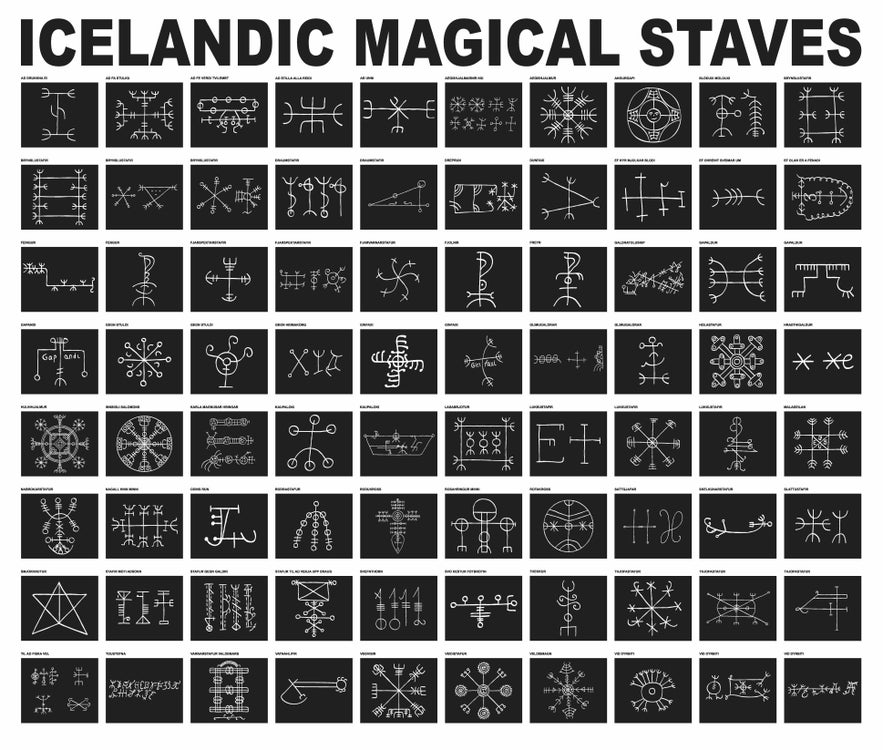 Icelandic Magical Staves, known as galdrastafir, are a unique part of Iceland’s esoteric heritage. These intricate symbols were a visual form of folk magic and were believed to hold protective, guiding, or fearsome powers. Each stave had a specific purpose. Some were meant to ward off evil, instill fear in enemies, locate lost objects, or bring luck.
Icelandic Magical Staves, known as galdrastafir, are a unique part of Iceland’s esoteric heritage. These intricate symbols were a visual form of folk magic and were believed to hold protective, guiding, or fearsome powers. Each stave had a specific purpose. Some were meant to ward off evil, instill fear in enemies, locate lost objects, or bring luck.
Above, you can see examples of the many different magical staves in Icelandic culture. Unlike runes, which formed part of a written alphabet used across Germanic cultures, galdrastafir were not tied to sound or language. They had no spoken equivalent. Instead, they functioned purely as visual spells.
How They Were Used
Magical staves were often paired with chants, rituals, or written instructions. Some were drawn with blood or ink. Others were carved into animal hides, etched into bones, or inscribed onto wood or paper. These staves were usually passed down through handwritten grimoires—books of spells that combined Christian elements, Norse mythology, and local superstition.
Sources and Manuscripts
Most known staves come from early modern Icelandic manuscripts. The best-known among them is the Galdrabok, also referred to as Galdrakver. This 17th-century grimoire contains dozens of magical signs and their uses. While often assumed to be Viking in origin, nearly all surviving examples were recorded centuries after the Viking Age had ended.
Major and Lesser-Known Staves
Among the most recognizable staves are the Aegishjalmur (Helm of Awe), said to inspire fear and provide protection, and the Vegvisir (Wayfinder), said to keep one from losing their way.
Other examples include Gapaldur and Ginfaxi, used to gain the upper hand in wrestling; Lukkustafir, for attracting good luck; Thjofastafur, intended to expose thieves; and Draumstafir, used to influence dreams.
Legacy and Belief
Though post-medieval in origin, these staves reflect a long-standing Icelandic belief in hidden forces and magical intervention. The harsh landscape, cultural isolation, and blending of Christian and Norse spiritual traditions all contributed to this symbolic system. Today, galdrastafir remain a compelling part of Iceland’s mystical and cultural identity.
- See also: Icelandic Runes and Staves | The Complete Guide
- Read more: Witchcraft and Sorcery in Iceland
What Is the Vegvisir?
Vegvisir, often called the “Viking compass,” is a magical stave found in Icelandic folk tradition. Its name combines vegur (“way” or “road”) and visir (“guide” or “pointer”), translating roughly to “that which shows the way.”
First recorded in the Huld Manuscript in 1860, the Vegvisir compass was said to help its bearer avoid getting lost, even when the way was unknown. Its design features eight unique arms radiating from a central point, resembling a symbolic compass rather than a practical one.
Though it’s frequently associated with Viking lore, there is no evidence it was used during the Viking Age. Instead, it belongs to a later tradition of Icelandic folk magic.
Symbolic and Modern Interpretations
In the Huld text, the Vegvisir appears alongside a note claiming that “if this sign is carried, one will never lose one’s way in storms or bad weather, even when the way is not known.” Some modern interpretations take this literally, but others view it as a symbol of emotional or spiritual direction.
Despite its relatively late appearance in written sources, many see the Vegvisir as reflecting older, oral traditions that valued visual symbols as charms or wards.
Its radial structure, while resembling a compass rose, does not align with cardinal directions. Instead, its eight arms may represent metaphoric paths or life challenges, with the central point symbolizing the self.
What Is the Aegishjalmur?
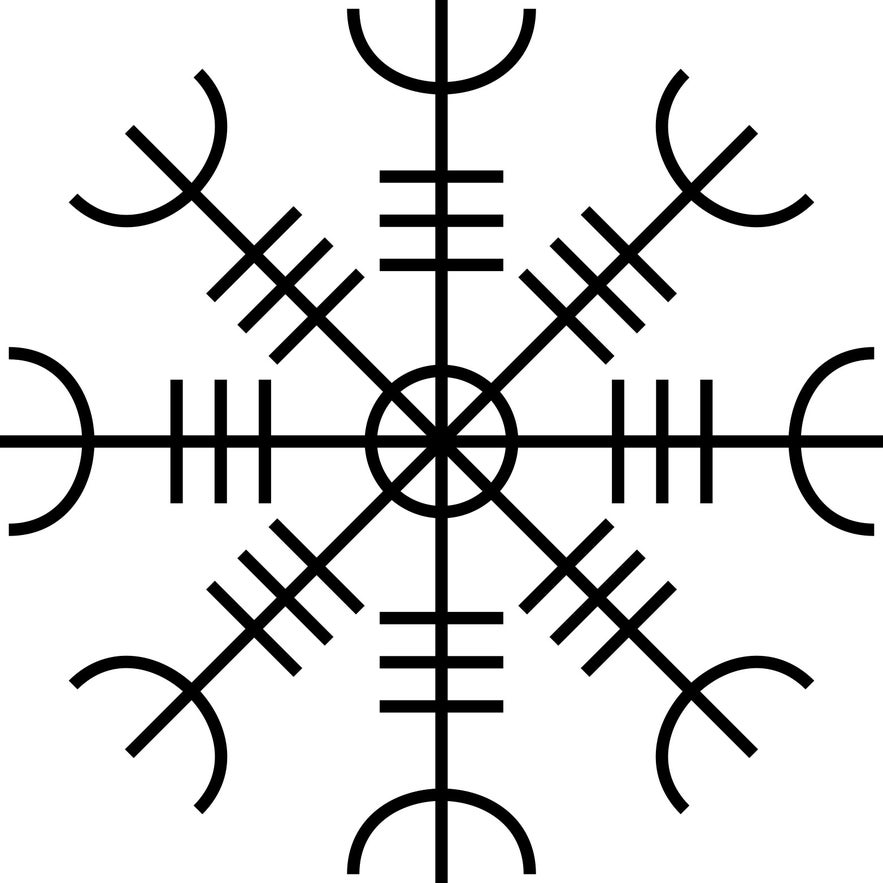
The Aegishjalmur, or “Helm of Awe,” is another Icelandic magical stave known for its association with fear and strength. The name combines aegis (“awe” or “terror”) and hjalmur (“helm” or “helmet”).
Though referenced in the Norse poem Fafnismal from the Poetic Edda, the symbol’s visual form appears in later sources. A well-known version comes from Galdrakver (also referred to as Galdrabok), an Icelandic grimoire from around 1670 that describes the stave as one to be marked between the eyebrows to overcome enemies.
A similar stave with a different design appears in En islandsk svartkonstbok, a Swedish manuscript from around the same period. There, Aegishjalmur is described as calming anger, though it is still applied to the forehead. An even earlier form of the symbol exists in a Danish manuscript dated between 1490–1510, visually closer to the Swedish version than the Icelandic one.
The Icelandic version typically features eight tridents radiating from a central point, forming a symmetrical and intimidating shape. This repetition may have been designed to overwhelm or confuse the viewer.
Mental Defense and Symbolic Strength
In magical practice, Aegishjalmur was more than a protective charm. It served as a psychological shield. The Galdrabok outlines its use in rituals that involve applying the symbol to the forehead and reciting spells, linking it to the idea of the “third eye” and inner control.
Modern interpretations often frame the stave as a tool of mental fortification, meant to sharpen resolve, project dominance, and ward off negative energies.
The Aegishjalmur and Vegvisir are preserved at the National and University Library of Iceland. Both have been digitized and are available online— see the Aegishjalmur and the Vegvisir. The full books are available to browse through the library’s digital archive.
Vegvisir vs. Aegishjalmur: Key Differences
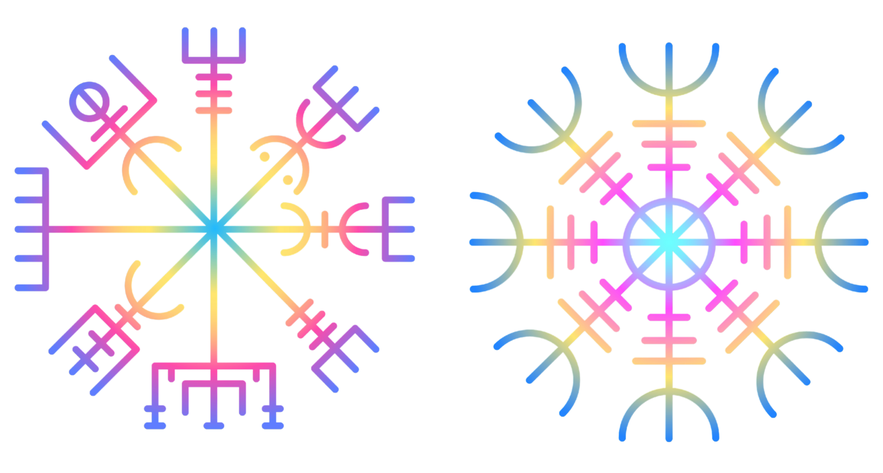
Intent and Emotional Tone
At its core, the Vegvisir offers direction and reassurance. Its meaning is rooted in navigating difficulty without losing one’s way, making it a symbol of inner focus and spiritual clarity. The energy it conveys is calm, grounded, and quietly protective.
The Aegishjalmur, on the other hand, is meant to assert dominance and repel threats. It evokes awe or even fear, offering a kind of psychological armor rather than gentle guidance. Its presence is commanding and confrontational.
Symbolic Roles in Folk Magic
The Vegvisir’s role was closely tied to travel, decision-making, and surviving metaphorical or literal storms. It was drawn to ensure the bearer would stay safe and centered through challenges.
The Aegishjalmur had a different goal: protection through power. In folklore and manuscripts, it was used to unnerve enemies and safeguard one’s strength in hostile situations, especially in battles of will or fear.
Visual and Structural Contrast
Both symbols use radial symmetry and eight arms, but the visual tone they strike is dramatically different. The Vegvisir’s varied, delicate shapes resemble direction markers or runic signs. It looks like a spiritual compass.
The Aegishjalmur’s repeated, spiked tridents form a tight, weapon-like grid. Its aggressive symmetry communicates focus, resistance, and impenetrability.
Cultural Positioning and Mythic Associations
The Aegishjalmur appears to have a closer conceptual tie to Old Norse mythology, particularly through its mention in the Poetic Edda. Even though its visual form is later, it carries a legendary aura.
The Vegvisir, while meaningful, has no mythological roots. It first appears in 19th-century manuscripts and reflects Icelandic folk beliefs rather than Viking myth. Its spiritual appeal is more personal than heroic.
Modern Appeal and Why People Choose Them
Today, the Vegvisir compass is popular among those seeking self-guidance, inner peace, or a reminder to stay true to their path. It appeals to travelers, creatives, and anyone navigating personal transformation.
The Aegishjalmur resonates with those who want to embody resilience, power, or unshakable strength. It’s a popular choice for people overcoming hardship, seeking bold symbolism, or honoring ancestral might.
You can view both symbols up close at the Museum of Icelandic Sorcery and Witchcraft, located in Holmavik. It’s one of the most immersive places to explore Iceland’s folk magic tradition and features reconstructed staves from original grimoires. If you're planning a trip to the region, Westfjords tours offer more incredible experiences in the area.
Popularity and Tattoo Culture of Vegvisir and Aegishjalmur
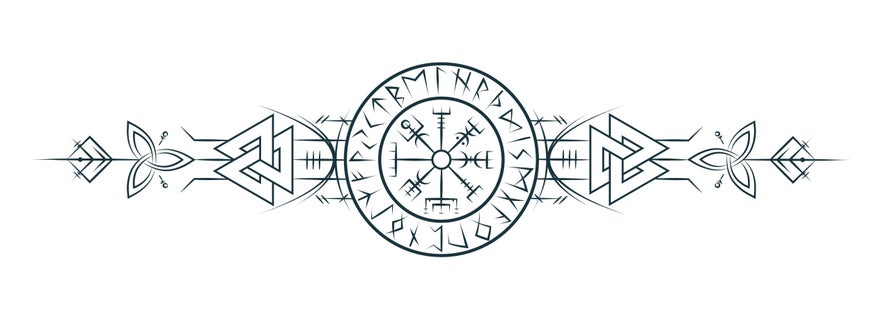
From historic manuscripts to modern skin art, the Vegvisir and Aegishjalmur have taken on new life far beyond their original magical contexts. Their striking designs and symbolic depth have made them favorites in contemporary culture, especially among those drawn to Norse heritage, spirituality, and visual storytelling.
A Surge in Global Appeal
In recent years, both Vegvisir and Aegishjalmur have surged in global popularity. They are especially common in tattoo culture and Norse-inspired fashion. Their mystical roots lie in Icelandic folk magic, but modern interpretations often reflect personal meanings that go far beyond their original use in grimoires.
Cultural Influence and Misconceptions
Celebrities have also played a role in spreading these symbols. Icelandic artist Bjork, for example, has a Vegvisir tattoo on her arm. Her embrace of Icelandic cultural heritage through music and visual art has helped bring symbols like the Vegvisir and Aegishjalmur into the international spotlight.
However, this growing popularity comes with a risk of misinterpretation. Many people assume these are Viking symbols or part of the Norse religion, which is historically inaccurate.
While both staves draw upon Norse concepts of protection and mysticism, their actual recorded appearances date from centuries after the Viking Age. They belong to Iceland’s post-medieval magical tradition, not Viking warfare or navigation.
Frequently Asked Questions About Vegvisir and Aegishjalmur
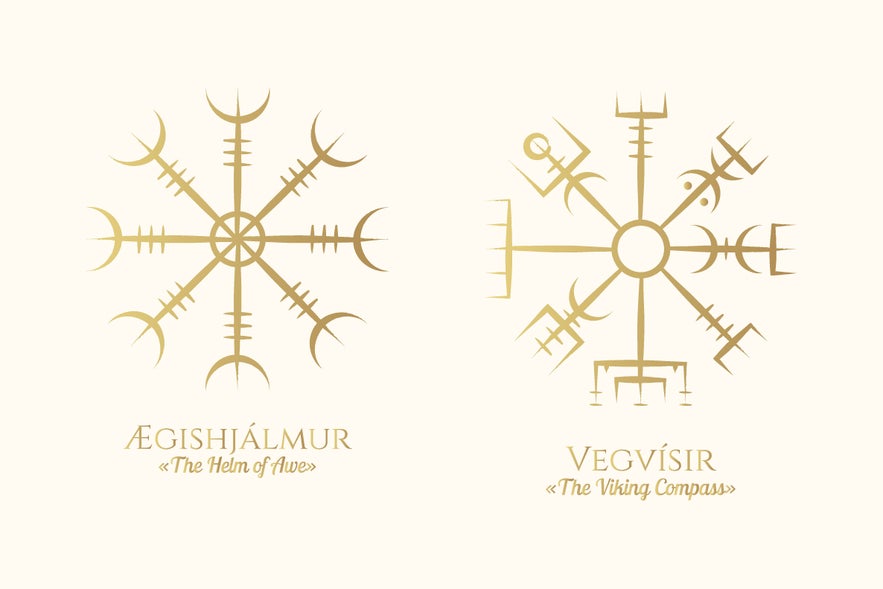 Vegvisir and Aegishjalmur are among the most recognized Icelandic magical staves, but their meanings, origins, and uses are often misunderstood. Below are some of the most common questions to help you explore their purpose and symbolism.
Vegvisir and Aegishjalmur are among the most recognized Icelandic magical staves, but their meanings, origins, and uses are often misunderstood. Below are some of the most common questions to help you explore their purpose and symbolism.
Are Vegvisir and Aegishjalmur Viking symbols?
No, Vegvisir and Aegishjalmur are not Viking-era symbols. They appear in post-medieval Icelandic grimoires, not in artifacts or records from the Viking Age.
What does the word Vegvisir mean?
Vegvisir means “wayfinder” or “signpost” in Icelandic. The name reflects its purpose as a symbol to help someone stay on course, even when the path is uncertain.
Is Aegishjalmur mentioned in Norse literature?
Yes, Aegishjalmur is mentioned in the Poetic Edda, specifically in the poem Fafnismal. In it, the dragon Fáfnir claims the “Helm of Awe” gave him great power and fearsome strength.
Where did Vegvisir originate?
Vegvisir was first recorded in the Huld Manuscript in 1860. It likely stems from Icelandic folk magic traditions and represents a later evolution of protective stave culture, rather than a medieval or Viking-age practice.
What do the arms of Vegvisir represent?
The eight arms of Vegvisir are thought to symbolize protection in every direction. Rather than representing compass points, they reflect the idea of being guided and shielded through life’s uncertainties, whether physical or emotional.
How was Aegishjalmur traditionally used?
Aegishjalmur was traditionally drawn on the forehead or between the eyes to invoke fear in enemies and boost inner strength. Some accounts mention using blood or magical ink and reciting specific phrases as part of the ritual.
Do Vegvisir and Aegishjalmur have Christian influences?
Yes, both staves appear in manuscripts that blend Christian elements with older magical traditions. Many Icelandic grimoires include prayers, biblical references, and crosses alongside the staves.
Was Vegvisir ever used for navigation?
No, Vegvisir was not a physical navigation tool like a compass. It was a symbolic talisman believed to prevent the bearer from becoming lost.
Are there any rituals tied to Aegishjalmur?
Yes, several sources describe rituals associated with Aegishjalmur. These include drawing it in secrecy, using blood instead of ink, choosing specific lunar phases, or chanting over it to activate its power.
Why are Vegvisir and Aegishjalmur so common in tattoos?
These symbols are widely used in tattoos because of their bold geometric design and deep meanings. Vegvisir symbolizes guidance and clarity, while Aegishjalmur stands for strength and protection, making both appealing to people seeking personal symbolism.
Can I combine Vegvisir and Aegishjalmur in one design?
Yes, many people combine them in modern tattoos and art. Historically, they served different functions and weren’t used together, but blending them today can reflect a desire for both inner strength and guidance, as long as the context is understood.
Is it okay to wear Vegvisir or Aegishjalmur if I’m not Icelandic?
Yes, it’s okay to wear these staves even if you’re not Icelandic, as long as you do so respectfully. Learning their meanings and origins shows appreciation rather than appropriation, especially important with culturally significant symbols.
How do modern Icelanders feel about people using these symbols?
Modern Icelanders generally accept the use of Vegvisir and Aegishjalmur in tattoos or art, especially when approached with respect. Many see them as part of Iceland’s cultural identity, not just magical relics.
The Enduring Power of Vegvisir and Aegishjalmur
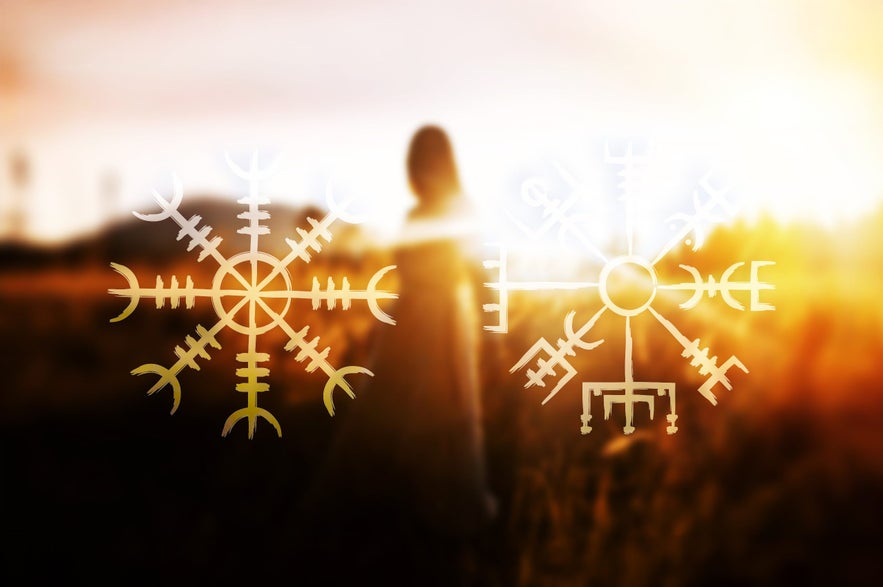 The lasting appeal of the Vegvisir and Aegishjalmur lies in their adaptability. Whether chosen for spiritual meaning or aesthetic design, these staves continue to inspire people to find strength, stay grounded, or move forward, just as Icelandic folk magicians once intended.
The lasting appeal of the Vegvisir and Aegishjalmur lies in their adaptability. Whether chosen for spiritual meaning or aesthetic design, these staves continue to inspire people to find strength, stay grounded, or move forward, just as Icelandic folk magicians once intended.
Though rooted in post-medieval magic, their modern use reflects a timeless human desire for protection, clarity, and resilience.
Vegvisir speaks to those seeking direction, while Aegishjalmur resonates with those wanting strength. Whether you wear them, draw them, or simply admire their meaning, these staves still hold power today. Which symbol speaks to you more, and why? Share your thoughts in the comments below.

